Baths for the disabled and the elderly: types and choices

Baths for the disabled and the elderly are a fairly new invention, but they have already won the attention of consumers. The popularity of such models is due to the ease of use, well-thought-out design and the presence of a large number of additional functions.
Peculiarities
People with disabilities of the musculoskeletal system and retirees often experience difficulties in carrying out hygiene procedures and need outside help when taking a bath. For many of them, this causes psychological discomfort and makes them want to wash themselves.
Persons with disabilities find themselves in a similar situation, especially wheelchair users and sedentary categories of elderly people.

However, in this case, we are talking not only about psychological discomfort, but also about very heavy physical exertion of the attendants or relatives.who literally carry the infirm on themselves to the bath and back. Such transportation does not add health to patients or people caring for them, and often leads to injury. In addition, even quite mobile elderly people are often injured in baths, and the nature of their damage is not limited to simple bruises, but includes muscle sprains and bone fractures.

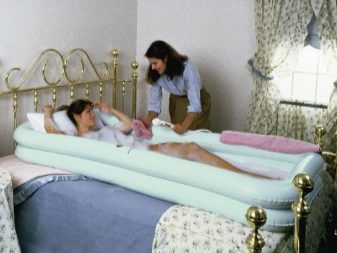


In order to somehow facilitate the procedure for washing an elderly person, people installed ordinary stools and benches in the bathtubs, but this did not ensure the safety of pensioners and sometimes led to even greater injuries. To prevent such situations, designers, under the strict guidance of doctors, invented specialized models for the disabled and the elderly, meeting all the safety requirements of people with limited mobility and greatly facilitating their care.


Modern models allow the elderly to take a bath, who are able to take care of themselves, without the risk of falling when entering or leaving it. Thanks to a special anti-slip surface and all kinds of devices, water procedures are no longer a difficult and time-consuming procedure for them and can be carried out at any convenient time and without the help of relatives.
As for the disabled, the creation of specialized models was a real breakthrough in the field of caring for sedentary people, greatly facilitated the life of relatives and allowed many people with disabilities to wash themselves.
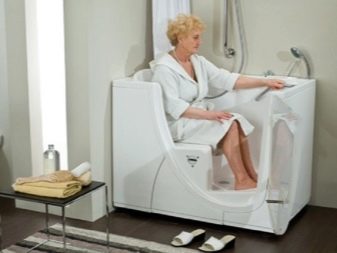



Varieties
Today, there are several varieties of models for people with disabilities and the elderly. Among them, there are both narrow-profile samples intended for wheelchair users or bedridden patients, and universal reservoirs for rather vigorous pensioners.



The most convenient design in all respects is considered bath with a door. These models are equipped with waterproof door seals and a locking system that prevents accidental opening. The door can be located on the right or left side, there is often a seating area in the bowl and overflow protection is provided. Taps and showers are located in a free reach, and the latter can be adjusted in height. The bottom of such models is covered with a special anti-slip compound that prevents slipping both in a filled and in an empty bath.
In addition to the high seated options, there are designs with low sides, suggesting lying or reclining baths. The necessary option is chosen depending on the nature of the person's disease and on the level of his mobility.

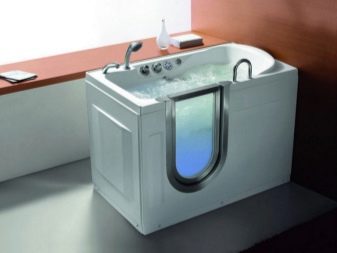

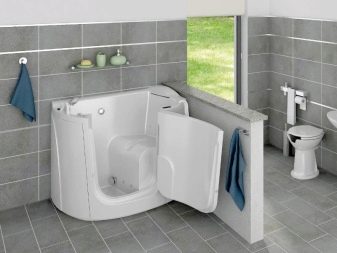
A roll-over bath is a unique design for people with disabilities. The reservoir has a gentle slope on one side, which allows you to transfer to the bath directly from the wheelchair. Next, the person plugs the drain hole and turns on the water. As it fills with liquid, the bath takes a horizontal position, which allows you to fully bathe yourself without resorting to the help of relatives. At the end of the procedure, the drain plug is removed, the water begins to leave, and the edge of the bath returns to its original position to the level of the stroller.


Inflatable baths are intended for bedridden patients and can be used directly in bed. Products are equipped with a compressor and hoses to maintain the required pressure inside the inflatable structure. In addition to full-size models that allow you to place a person at full height, there are compact models designed for shampooing. The advantages of inflatable products are low weight and no need to carry the patient to the bathroom.
The person is carefully transferred to a straightened deflated bathtub, then pumped up with a compressor and filled with water. After bathing, all manipulations are performed in the reverse order.


Hot tubs are ideal for sedentary people. With the help of various nozzles, it is possible to carry out a gentle, but at the same time very effective massage. This prevents bedsores in bedridden patients and improves the condition of people suffering from muscle pain and skin problems.
What's more, whirlpool baths are relaxing, stress-relieving and preparing the body for sleep.
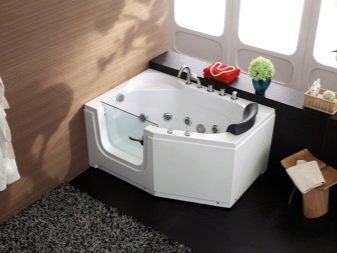


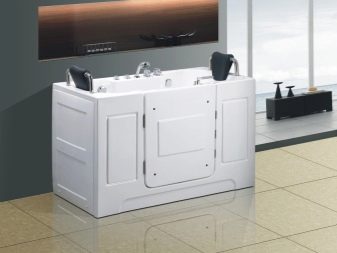
Additional accessories
Specialized baths for disabled and elderly people are quite expensive, and often people do not have the means to purchase such plumbing fixtures.In this case, additional devices will come to the rescue, helping to make an ordinary bath comfortable and safe for this category of citizens.
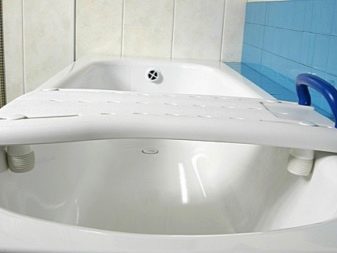



Chair
Used by older people who find it difficult to sit on the bottom of the bathtub while washing and even more difficult to get up afterwards. These chairs have anti-slip tips on legs or are equipped with rubber suction cups. The seats are made of plastic or wood, and the legs, often telescopic, are made of metal. Thanks to the sliding design the chair can be adjusted in height to suit the height of the person.
They are considered very comfortable models with four legs, two of which are installed in the bathtub and two on the floor. Such products are distinguished by good stability and provide a person with complete safety.


Seat
Bath seats are also popular with retirees. Unlike chairs, they don't need to be installed and removed every time. Most models have a tilt or swivel mechanism, which allows you to simply take it out of the bath when not needed. Often, the seats are designed as comfortable benches with armrests, backrests and a hygienic opening. Many of them have the ability to adjust the height.




Handrail
Handrails are also an effective assistive device. and help people with limited mobility and the elderly to move to the bath. Modern models of handrails are made of durable materials with an anti-slip coating. In some samples, this coating is replaced by a plastic sheath.
For a more comfortable grip, most handrails are 3 cm in diameter.
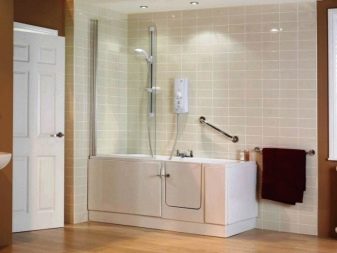

With their help, you can not only sit in the bath, but also adhere to, taking out bath accessories from the shelves. The handrails are fastened in an extremely rigid way, using steel fasteners. The use of models with vacuum suction cups is unacceptable, as there is always a risk that they will fall off the bath or wall.



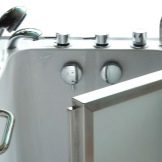
Ladder
The ladder is another important fixture and is designed for tall baths. Most models are side-mounted and equipped with anti-slip steps and handrails to prevent injury. Ladders are selected taking into account the height and physical capabilities of the elderly person, as well as the height of the sides of the bath. The simplest option is an attached single step without handrails. However, to use such a model the person should be in good physical condition and not have problems with coordination.


More expensive models have lighting, aromatherapy function, heating, ozone water sterilizer and a soft headrest.
How to choose?
There are no universal tips for choosing a bathtub for the disabled, since there is a different option for each specific case. This takes into account both the nature of the disease and the general physical condition, as well as the individual characteristics of each person and how much he needs the help of strangers.
For example, for one person, for independent bathing, it will be enough to purchase an accessory step, another will need a model with a door, and a third person will be able to use only a cross-over bath. Perhaps the common prerequisite for all types of baths is anti-slip coating that helps to minimize the number of injuries.

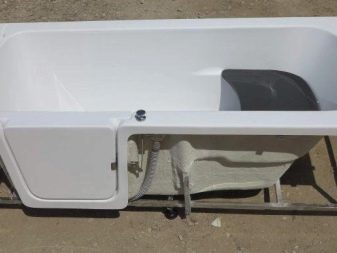


As for the models for retirees and mobile seniors, in this case you should focus on the preferences of the person himself and take into account in what position he wants to take a bath... Most of the specialized models have a length of 105 to 130 cm, which allows you to swim while sitting.
From a safety point of view, this is considered the most optimal option than washing while lying down and negates the likelihood of accidents if a person suddenly becomes ill while washing. The exception is the baths for recumbent - their length is 220 cm.For a person who is able to serve himself on his own, the best option would be a model with a size of 130x100x70 cm.

And the last selection criterion is the price. The cost of tanks varies greatly depending on their functionality. The most expensive are sit-down baths with a door, the price of which starts at 80 thousand rubles, and the most advanced specimens cost 130-150 thousand rubles. The most budgetary ones are classic baths with low sides: their cost is comparable to the cost of traditional baths and varies from 5 to 10 thousand rubles.
Despite the high cost of most specialized baths, their purchase is fully justified. An elderly person or a disabled person receives not only a comfortable and functional thing, but also gains self-confidence. This allows him to increase self-esteem and independently satisfy his urgent needs, without resorting to the help of relatives.


The following video will tell you about baths for the disabled and the elderly.








